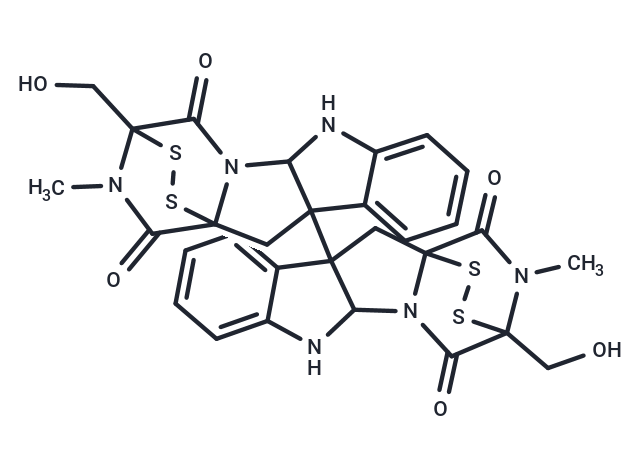Shopping Cart
- Remove All
 Your shopping cart is currently empty
Your shopping cart is currently empty

Chaetocin, a natural product from Chaetomium species, is a histone methyltransferase inhibitor with IC50 of 0.8 μM, 2.5 μM and 3 μM for dSU(VAR)3-9, mouse G9a and Neurospora crassa DIM5, respectively.

| Pack Size | Price | Availability | Quantity |
|---|---|---|---|
| 1 mg | $129 | In Stock | |
| 5 mg | $396 | In Stock |
| Description | Chaetocin, a natural product from Chaetomium species, is a histone methyltransferase inhibitor with IC50 of 0.8 μM, 2.5 μM and 3 μM for dSU(VAR)3-9, mouse G9a and Neurospora crassa DIM5, respectively. |
| Targets&IC50 | G9a (mouse):2.5 μM, DIM5 (neurospora crassa):3 μM, dSU(VAR)3-9:0.8 μM |
| In vitro | In SL-2 Drosophila tissue culture cells, Chaetocin causes the inhibition of SU(VAR)3-9 and the number of H3 molecules dimethylated at Lys9, and also inhibits cell growth. [1] In HepG2, Hep3B, and Huh7 human hepatoma cells, Chaetocin inhibits HIF-1-Mediated hypoxic responses. [2] Chaetocin also potently inhibits proliferation and colony formation in a broad range of cancer cell lines with IC50 of 2-10 nM. [3] |
| In vivo | In Hepa 1c1c-7 tumor-bearing mice, Chaetocin (0.25 mg/kg, i.p.) inhibits tumor growth by deregulating HIF-1[alpha]-mediated angiogenesis. [2] In SKOV3 tumor-bearing nude mice, chaetocin treatment (0.25 mg/kg, i.p.) significantly delays the tumor growth with minimal evidence of toxicities. [3] |
| Cell Research | HeLa cells are transfected with 1 μg pcDNA or pcDNA-Trx. Twenty four h after transfection the cells are treated with either DMSO, 100 nM chaetocin or 100 nM doxorubicin for 24 h. The cells are then trypsinized and manually counted in trypan blue to exclude dead cells. For immunoblotting (24 h after transfections), cells are trypsinized, ished in cold PBS, and lysed in CelLytic lysis buffer containing protease inhibitors. Protein is analyzed by BCA assay and lysates are electrophoresed on 15% SDS-PAGE gels and transferred to nitrocellulose. Immunoblotting for thioredoxin and actin is then performed[2]. |
| Molecular Weight | 696.84 |
| Formula | C30H28N6O6S4 |
| Cas No. | 28097-03-2 |
| Smiles | CN1C(=O)C23CC4(C(Nc5ccccc45)N2C(=O)C1(CO)SS3)C12CC34SSC(CO)(N(C)C3=O)C(=O)N4C1Nc1ccccc21 |
| Relative Density. | 1.87g/cm3 |
| Storage | store at low temperature,keep away from moisture | Powder: -20°C for 3 years | In solvent: -80°C for 1 year | Shipping with blue ice. | ||||||||||||||||||||
| Solubility Information | H2O: < 1 mg/mL (insoluble or slightly soluble) DMSO: 7 mg/mL (10.05 mM), Sonication is recommended. Ethanol: < 1 mg/mL (insoluble or slightly soluble) | ||||||||||||||||||||
Solution Preparation Table | |||||||||||||||||||||
DMSO
| |||||||||||||||||||||

Copyright © 2015-2025 TargetMol Chemicals Inc. All Rights Reserved.